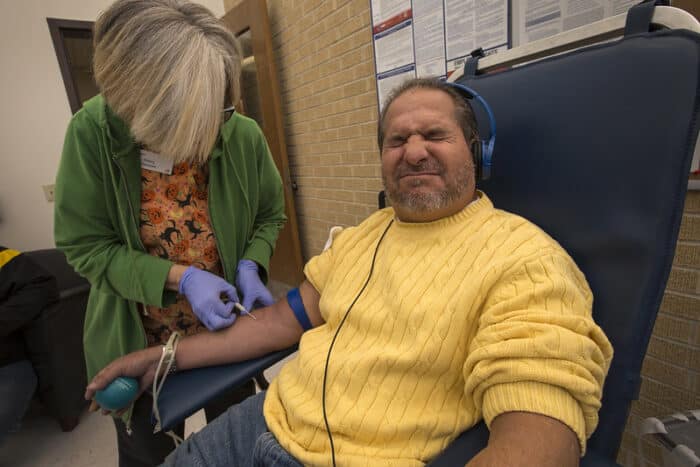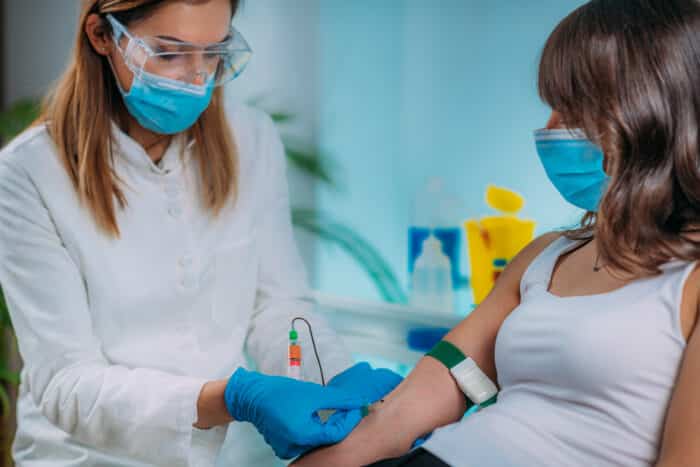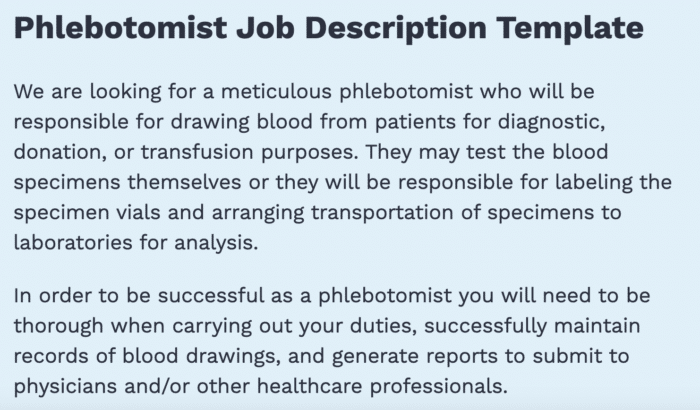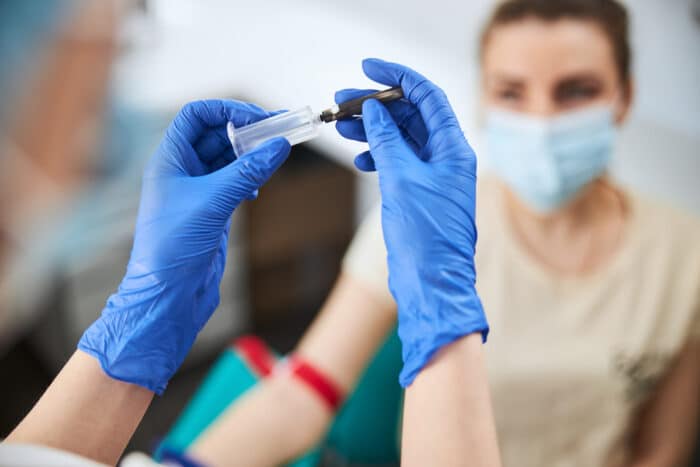If you’re an aspiring phlebotomist or are looking to switch your career to phlebotomy, you might have wondered what an employer looks for while hiring phlebotomists.
Or if you’re interested to know more about phlebotomy as a career, you might want to know what the roles and responsibilities a certified phlebotomist handles in their workplace.
We’ve got you covered with all of these queries today.
In this article, we will also uncover the requirements to become a phlebotomist, so that you can decide if this is the right career choice for you.
So, let’s dive in, shall we?
Job Template
A job template for a phlebotomist can be defined as an outline of a job opportunity that provides an overview of the roles and responsibilities, qualifications, and other expectations an employer looks for while hiring.
Also see: How to Become a Phlebotomist
Here is an example of a phlebotomist job template posting:
Phlebotomist Responsibilities
If you’re interested in this rewarding career, you might be wondering what the typical responsibilities of a phlebotomist look like on a daily basis.
Here is what you can expect in your day-to-day schedule as a phlebotomist:
- Checking patient identification by looking at their ID cards or documents.
- Understanding patient needs, checking their medical history, and finding out why blood needs to be taken.
- Choosing the right needles and prepping the veins or fingers for drawing blood.
- Drawing blood from patients’ veins or fingers using needles.
- Testing blood samples using the right equipment if and when required.
- Getting blood samples ready to be transported by labeling them accurately and matching them to the right patients.
- Sharing test results with doctors, nurses, and hospitals.
- Writing down patient names, how much blood was taken, and test results.
- Cleaning, fixing, and calibrating lab equipment used for drawing and testing blood.
- Getting more lab supplies if they’re needed.

Do You Want To Become a Phlebotomist? Check Out Free Phlebotomist Masterclass!
In our masterclass you learn:
- How to be a Phlebotomist faster…in just 2 months!
- Avoid student debt & driving to classes
- #1 thing employers want from Phlebotomists
- How to stand-apart & get a university certificate for a strong resume
Phlebotomist Requirements
The process of becoming a phlebotomist might sound intimidating, and you might be confused about the requirements to become one, due to the amount of information available online.
See: How To Choose Phlebotomist Classes Online?
We’re here to help you with that.
To become a phlebotomist, you need:
- Completion of a phlebotomy training program (Diploma, certificate, or online).
- Certification from the National Phlebotomy Association (NPA).
- A demonstrated experience in the phlebotomy field.
- Familiarity with accurate patient identification techniques.
- Understanding of legal regulations related to blood drawing, specimen handling, and medical equipment usage.
- Proficiency in successful puncture methods.
- Familiarity with testing procedures and equipment operation.
- Good dexterity and precise hand-eye coordination.
- Strong communication abilities, both written and verbal.
- An exceptional focus on details.
See: How Long Does it Take to Become a Phlebotomist
Conclusion
The role of a phlebotomist is essential in the healthcare field. Phlebotomists play a crucial part in collecting blood samples, ensuring patient comfort, and maintaining a safe and sanitary environment. This job offers a rewarding career path with opportunities for growth and advancement.
If you’re considering a career in healthcare that doesn’t require extensive years of education, becoming a phlebotomist could be a great choice. With the right training and dedication, you can embark on a fulfilling journey in this profession, making a positive impact on patient care and well-being.
Related Resources:
- Phlebotomist Salary
- Phlebotomist Requirements
- Phlebotomist Skills
- Day in the Life of a Phlebotomist
- Ultimate Phlebotomist Resume Guide – Phlebotomy Job
- What is the Main Responsibility of a Phlebotomist?
- Which Two Skills are Important for a Phlebotomist?
- What Do You Need To Be a Phlebotomist?
- Pros and Cons of Being a Phlebotomist
- Phlebotomy Externship
- Mobile Phlebotomist
- How Long Does it Take to Get a Phlebotomy Certification?
- What are the Different Types of Phlebotomy Certifications?
- How Long is a Phlebotomy Course?
- Therapeutic Phlebotomy
- Phlebotomy Course
- Phlebotomy Classes
- Online Phlebotomy Classes
- Phlebotomy Interview Questions
- Phlebotomist Career
- 4-Week Phlebotomy Classes Online
Related Articles
-
How to Be Successful in College in 2022 – 7 Simple Tips to Succeed
-
How Do Scholarships Work? Read This First…Truth is Shocking
-
7 Best College Majors 2024: What Should I Major In?
-
How to Choose a College – 10 Things You Must Consider in 2024
-
Why Go to College? Top 13 Benefits for Adult Students in 2022
-
Top 5 Best Alternatives to Community College for 2024









